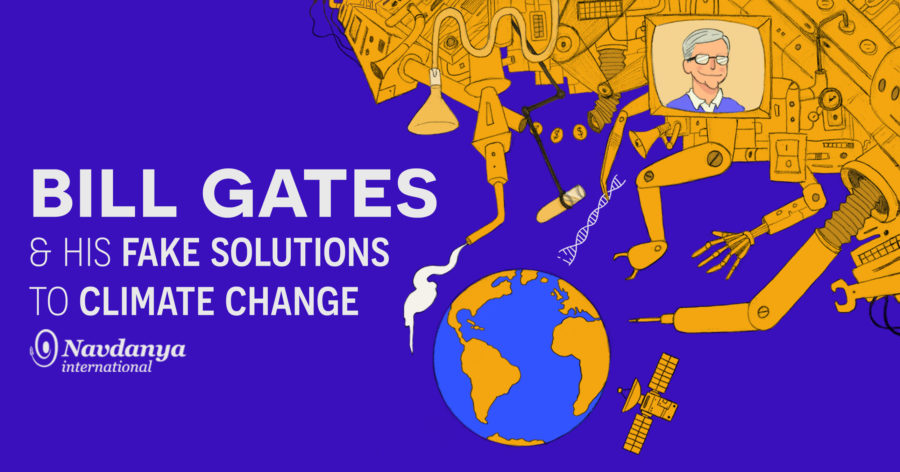
Browse: Techno Fixes will not Save our Planet – The Imposition of a Failed Agriculture Model
Global Commission on Adaptation – Breakthrough Energy Ventures: The Revolving Door for “Super Emitters”
The False Promise of Fake Food – Biodiversity and Agroecology are True Solutions to Climate Change
–
Download pdf
Techno Fixes will not Save our Planet
In his latest book, How to Avoid a Climate Disaster: The Solutions We Have and the Breakthroughs We Need, Microsoft co-founder Bill Gates lays out a plan to stop global warming by reducing greenhouse gas emissions to zero. A fact that seems a little ironic coming from one of the world’s largest emitters[1], whose “guilty pleasure” is flying on private jets and who just joined a bid to acquire the world’s largest private jet services company[2]. Though he attempts to waves this fact away by claiming to make sure that his miles are offset, and his jet uses only “sustainable fuel”. But this sort of contradiction, of placating a severe root problem with a superficial or false solution, is nothing strange for Gates, as a closer look into his million-dollar investments, billionaire and private company partnerships, and his political agenda show little alignment with the goal of truly curving climate change, helping alleviate world hunger, or lifting the poor out of poverty.
Gates’ unparalleled influence marks not only the extraordinary power of his wealth, but also a convergence of philanthropy, private corporations, and international institutions to shape policy and development landscapes to their own interests. But this shaping, while seemingly justified by a noble humanitarian and environmental cause, instead pushes a failed paradigm of industrialization and corporate concentration under the guise of necessary technological innovation.
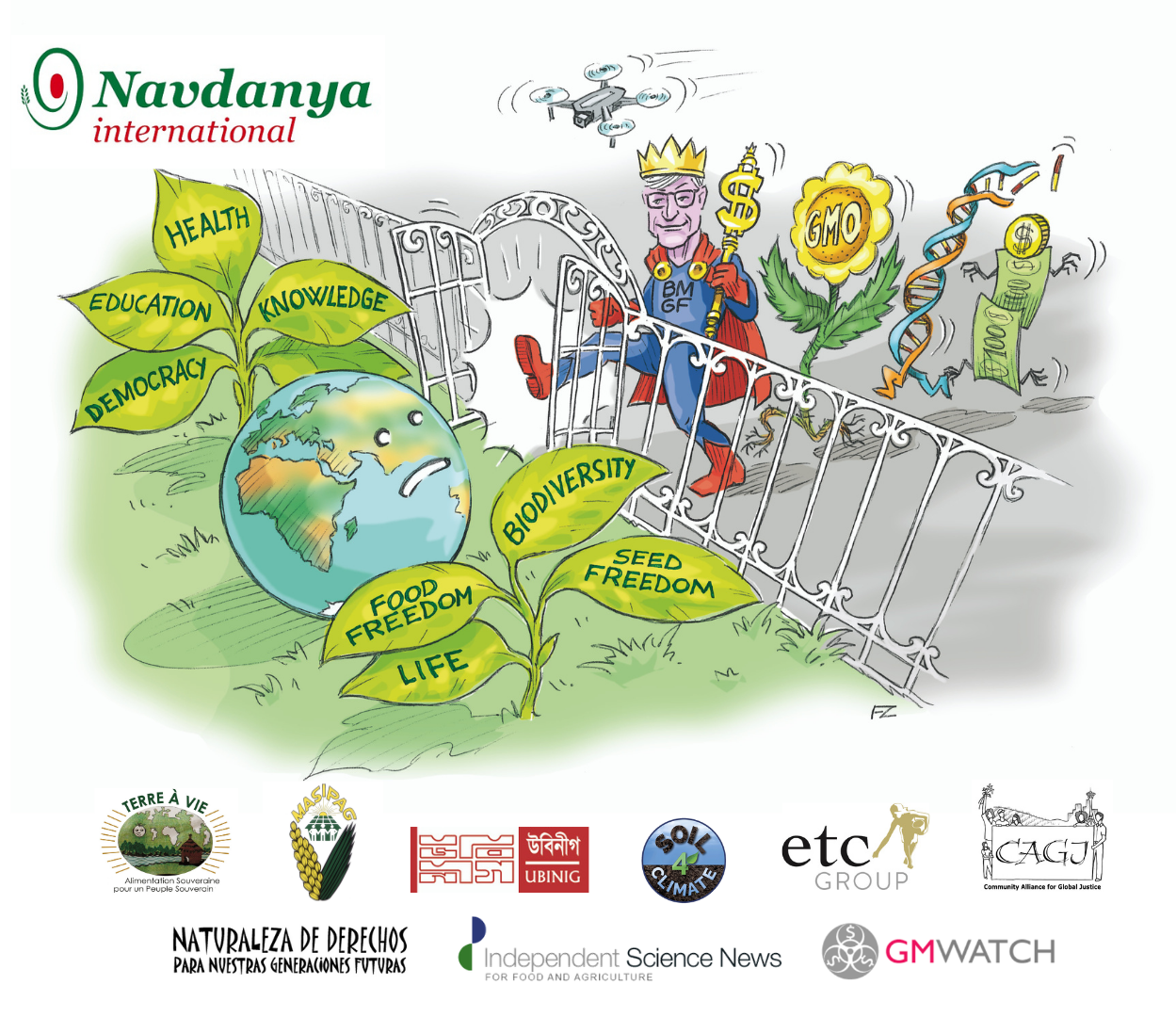
The Gates to a Global Empire report (October 2020), coordinated by Navdanya International, throws light on the dangers of philanthrocapitalism. This democratic emergency is analysed in detail by leading experts and civil society movements’ leaders.
While there is little doubt that we are living in moments of compounding crises, the push for new technological innovations as the path to solving the world’s problems is now quickly becoming the only mechanism. Creating a blind-spot for both the root causes of the crises we face, and how continually going down this path will only serve to exacerbate the crises further. But this avoidance of true systemic solutions is not an accidental overlook by a well-meaning technological innovations sector. Instead, it is resulting in the same giant corporations and power structures that created our current crises to sell us back their own proposed ‘solutions’.
This technological solutionism mentality is apparent in all of the Bill and Melinda Gates Foundation’s (BMGF) initiatives which, by their nature, end up denying real solutions to the climate crisis. These initiatives, grants, and development programs cover a vast area – such as food, agriculture, seed, health, climate change, education, media, infrastructure, and energy as shown in Navdanya International’s Gates to a Global Empire report[3] – and weave a complicated web of international power and influence to ensure specific interests. With the weight of investment capital held by both the Gates Foundation Trust and their personal wealth, in conjunction with their bought public media platform, Bill and Melinda Gates set the agenda across these different sectors with very little to no accountability. In the end, this works to align public opinion with private company investments, and international and state policy, to open up new markets through policy alignment and state co-investment in the name of ‘development’.
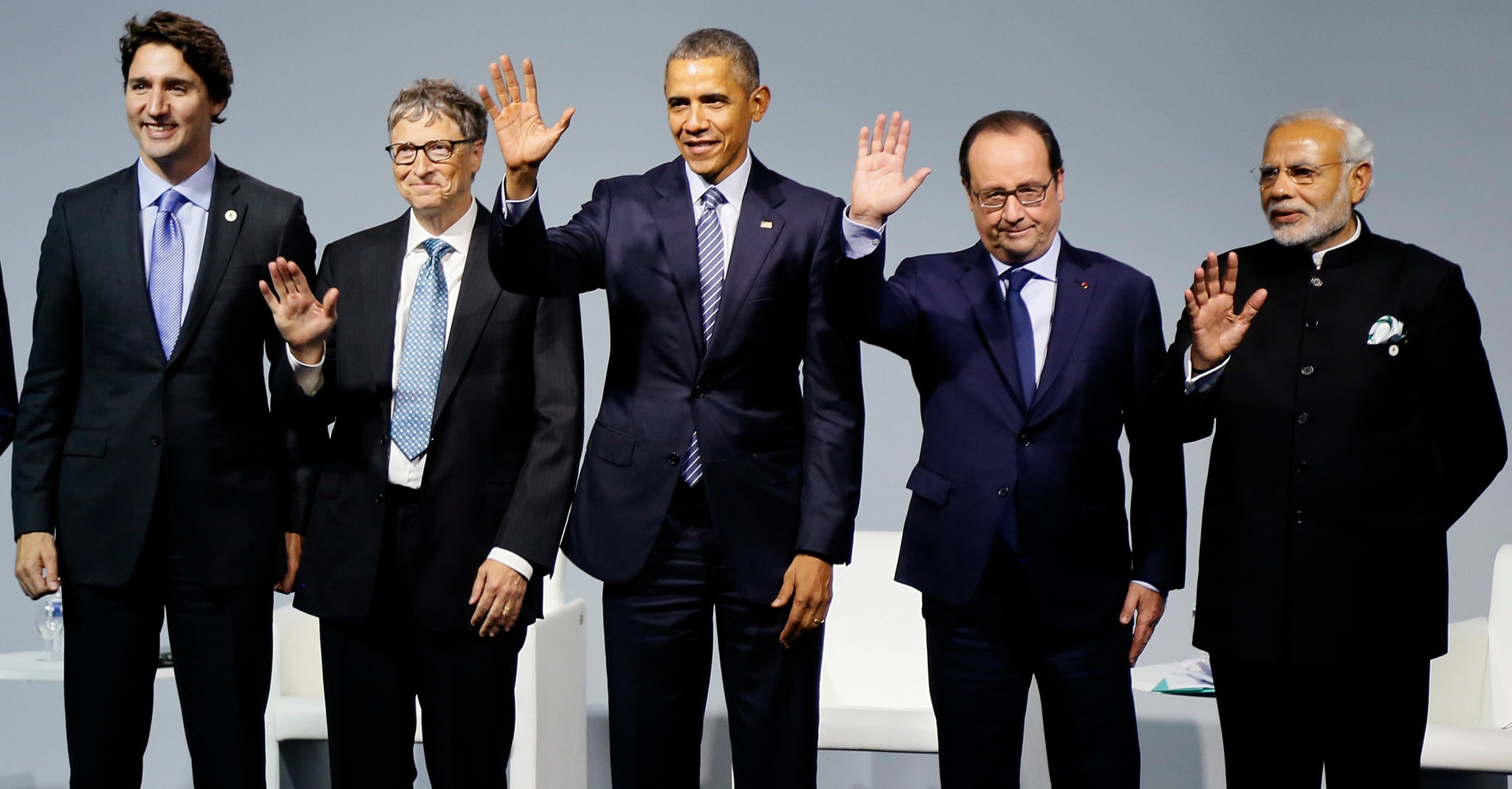
Gates and world leaders at the climate change conference in Paris, 2015 – © Ian Landson
A principal example is how he spreads his agenda authority over global health by investing in international health institutions, like the World Health Organization (WHO), for whom the Bill and Melinda Gates Foundation provides nearly 20% of the institution’s funds[4]. He aims to control education and the media, for instance, by funding scientific research establishments like Cornell University[5] and John Hopkins University, as well as providing generous grants to prominent newspapers[6] like the Guardian, BBC, and Al Jazeera to name a few, to publish stories aligned with his narratives.
Despite his pronouncement to help fight climate change, Gates also directly invests in the fossil fuel industry[7]. He is the largest shareholder[8] in one of Canada’s largest oil and gas companies, Canadian National Railway, while Microsoft also has direct ties to the oil and gas industries. As explained by ETC in “The Sugar Daddy of Geoengineering”[9], Gates has been one of the major supporters for extreme geoengineering (“miracle technologies”), Carbon dioxide Removal Techniques (CDR), Solar Geoengineering, and other such techniques alongside the fossil fuel industry for more than a decade. Techniques that could potentially lead to disastrous damage to the planet’s weather systems and natural cycles.
The Imposition of a Failed Agriculture Model
One of the major sectors where Gates’ private market and power interests are more apparent is in his push for agricultural transformation. The Gates Foundation has been pushing new technologies and an industrial agricultural model for decades, under the guise of putting an end to hunger and climate change.
In 2008, Gates attempted to revive the failed model of the 1960s Green Revolution in Africa by launching the AGRA[10] (Alliance for a Green Revolution in Africa) program, encouraging farmers to move toward large-scale, commercial monocultures and promoting synthetic fertilizers, pesticides, and high-yield or GMO seeds. Timothy Wise’s research explained in the Gates to a Global Empire report[11], shows how 15 years later, there is no evidence that the objectives set out by AGRA have resulted in significant productivity improvements and have instead triggered a 30% increase of people suffering from extreme poverty in AGRA countries. Demonstrating direct evidence of this initiative’s failure.
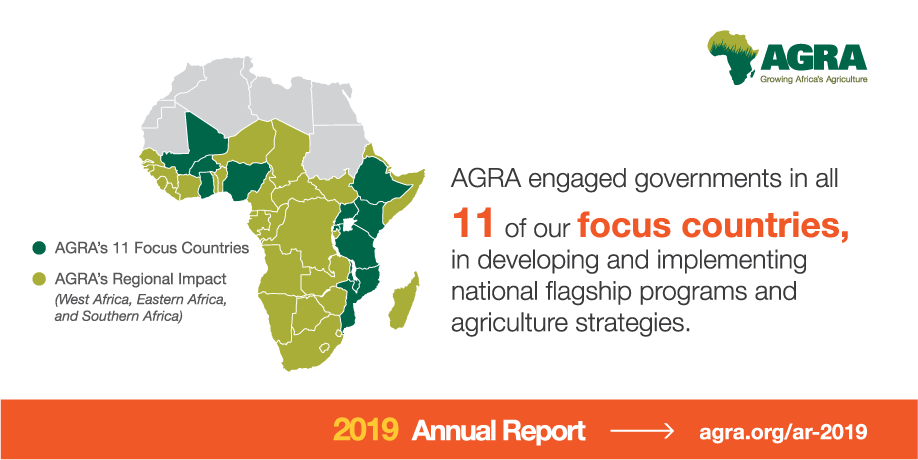
Source: AGRA
While many have come out to critique the failure of AGRA, it is not the only example of Bill Gates’ attempts to control what goes on in farmer’s fields. In January 2020, the Bill and Melinda Gates foundation launched Ag One[12], a new research institute that aims “to empower smallholder farmers with the affordable, high-quality tools, technologies, and resources they need to lift themselves out of poverty”. The goal is to promote Green Revolution techniques alongside new technological innovations, like data and sensor technology, precision agriculture, gene drives, GMOs, artificial intelligence predictive models, and so on, to increase crop productivity in Africa, Asia, and in Latin America as Ag Tech[13]. With the launch of Ag Tech, partnerships were also announced with the Inter-American Institute for Cooperation on Agriculture (IICA), Microsoft, Bayer, Corteva, and Syngenta, in addition to the Bill and Melinda Gates Foundation, giving rise to a dangerous alliance in Latin America of industrial agriculture firms and biotechnology.
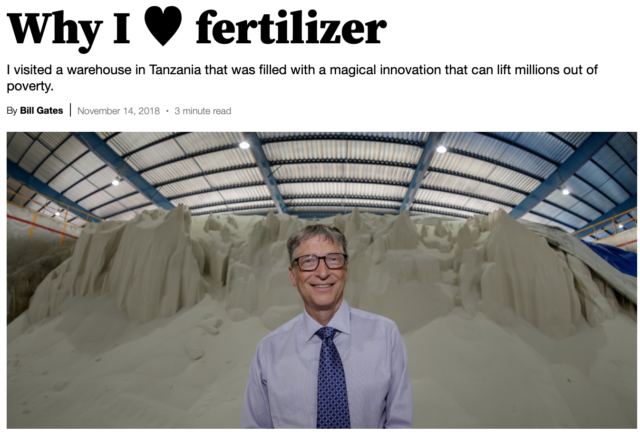
Source: Gates Notes
The BMGF clearly and proudly focuses on these partnerships and the perpetual pushing of the industrial agriculture paradigm. For instance, Gates’ enthusiasm for chemical fertilizers is well known, According to him, fertilizers are a “magical invention that can help lift millions of people out of poverty”[14], even though scientists say they emit dangerous amounts of greenhouse gases (GHG) [15], and are known environmental pollutants. Gates also sees GMO seeds as a “necessary technical solution” to agricultural development that could “end starvation in Africa”[16] regardless of their known failures, as well as their devastating environmental, social, health consequences. He has also publicly expressed his full-fledged support for highly problematic[17] gene editing methods like CRISPR-Cas9, which he has invested millions in[18]. His foundation also heavily funds the Consultative Group for International Agricultural Research (CGIAR) centers, which receive over 70%[19] of BMGF agricultural research investments, making Gates the second largest donor of CGIAR. These investments give Gates a considerable amount of influence, allowing him to shape the global agriculture and development policy agenda and serve as a convenient way to open up new markets for agribusiness and biotech in previously unprofitable or hard-to-reach markets. Policy alignment in these countries and these sectors then ensures a return on Gates’ investments.
Global Commission on Adaptation
One of the ways Gates silently pushes his vision and agenda is through the Global Commission on Adaptation[20], an international commission co-founded by Gates that pushes technological solutions to climate change adaptation and mitigation, through such things as filling in the ‘data gap’ of the global south through digital agriculture[21]. For example, the policy recommendations and position papers of the Commission triggered in 2018 a report co-authored by IICA and CGIAR[22] which bluntly stated that “climate change adaptation in agriculture is contingent on increased investment to modernize agricultural systems.” The report was actively endorsed by the heads of the Global Commission at the time.
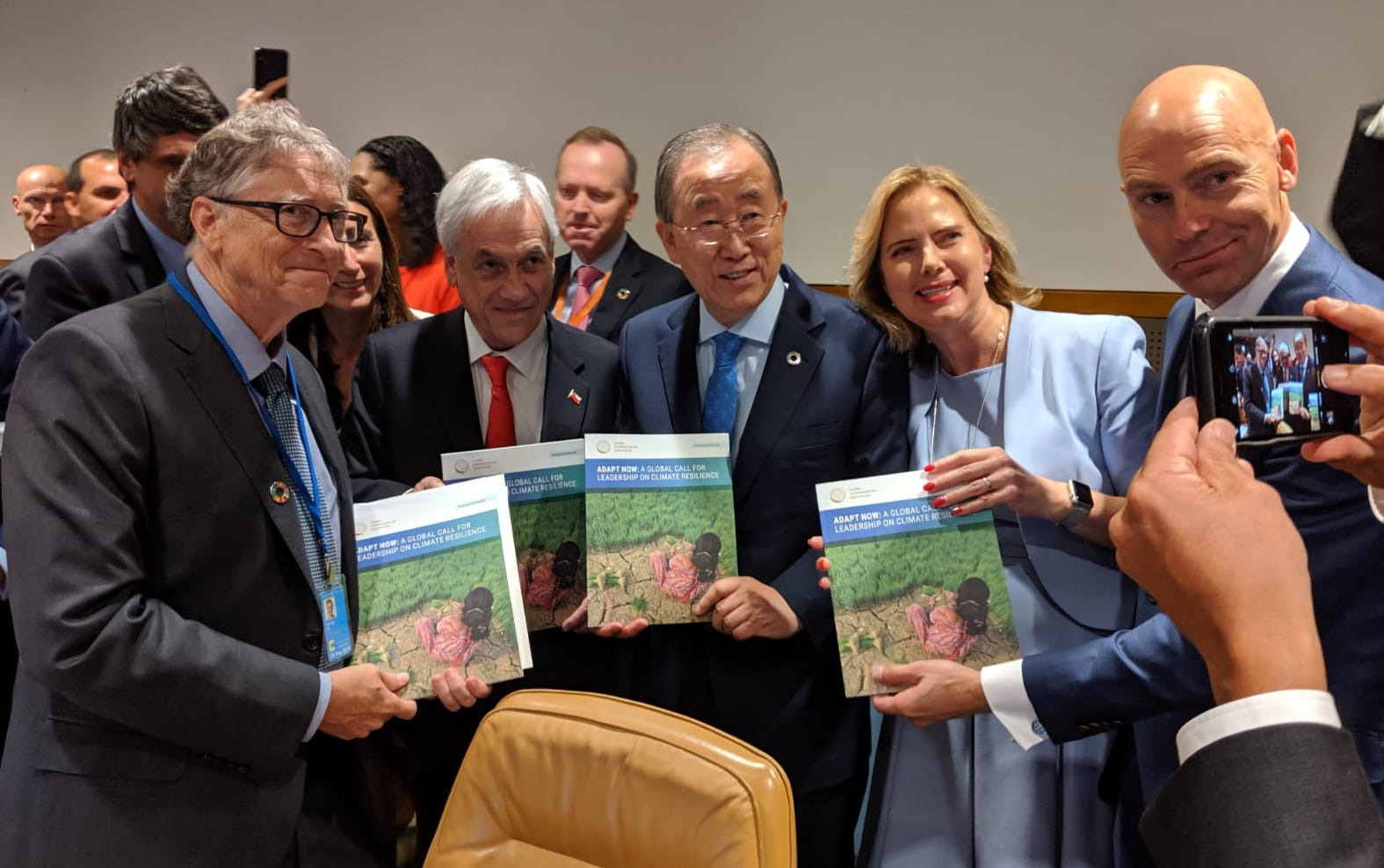
The Global Commission on Adaptation, co- founded by Gates, pushes technological solutions to climate change – Source: GCA
Founders of the commission also include Kristalina Georgieva, the current managing director at the International Monetary Fund (IMF) and former Chief Executive Officer of the World Bank; and the former 8th secretary-general of the UN, Ban-Ki Moon. The commission has 22 convening countries and is supported by a range of foreign ministers and ministries, policymakers, heads of development banks and development corporations, heads of the UN, and heads or former heads of governments. Since the end of its 2020 mandate, the board of directors no longer directly includes Gates, but still includes actors who remain close to the Gates agenda. These include Rodger Voorhies, the President of Global Growth & Opportunity Division of the BMGF and head of Ag One. As well as, Feike Sijbesma – current CEO[23] and honorary chairman of DSM, a synthetic biology and fake food company funded by Breakthrough Energy Ventures.
Breakthrough Energy Ventures: The Revolving Door for “Super Emitters”
While the political pushing of the industrial paradigm happens through development initiatives and policy lobby, where this game of billionaire profit-making and corporate partnerships is most clear is in one of Gates’ most prominent personal investment funds: Breakthrough Energy Ventures. Now being thrown into the spotlight as a symbol of Gates’ commitment to solving climate change, this investment fund is supported by other philanthrocapitalists[24] and billionaires such as Jeff Bezos, Mukesh Ambani, Michael Bloomberg, Richard Branson of Virgin Group, Reid Hoffman of LinkedIn, Jack Ma of Alibaba, former Enron trader and hedge fund manager turned philanthropist John Arnold, among other prominent names.
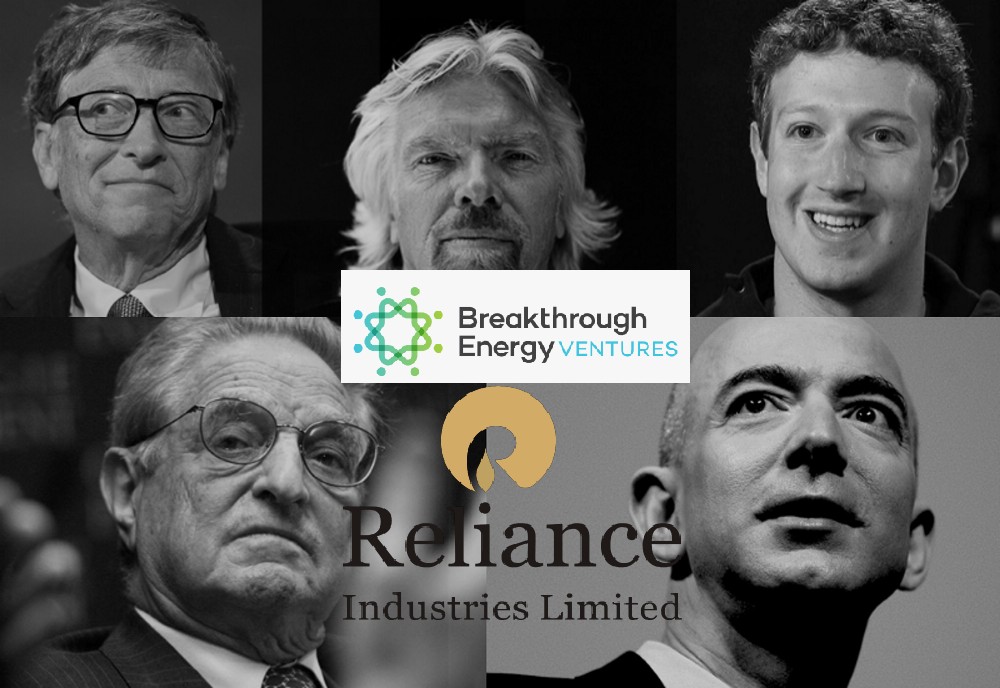
Breakthrough Energy Ventures is supported by several billionaires and philanthrocapitalists, including (from left): Bill Gates, Richard Branson, Mark Zuckerberg, George Soros, Jeff Bezos – Source: Great Game India
Out of the multiple startups funded by Breakthrough, seven are involved in the areas of food and agriculture, particularly through the development and marketing of synthetic biology and biotechnology products. While these startup companies use the greenwashed rhetoric of promoting ‘sustainable climate solutions’, a closer look reveals the company’s leadership teams to be riddled with ex DuPont, Monsanto, Bill and Melinda Gates Foundation, PepsiCo, and Microsoft executives. Raising the question, how can people involved in the very companies which created our health, ecological, and climate crisis, be in any way qualified to sell us back the ‘solution’?
A direct example of the overlap between industrial food and agriculture and the new tech-companies is, Motif Foodworks[25] a synthetic biotech company that works to create and market “plant-based alternatives” to meat and dairy products, as well as creating finished food products and ingredients. The startup makes its claim to sustainability by referencing its lack of need for land, agricultural inputs, and intensive external resources while providing enhanced nutrition. They have an exclusive partnership with prominent, and also Gates-funded, synthetic biotech firm Ginkgo Bioworks[26], which creates products for pharmaceutical companies, such as Moderna, industrial chemicals, and industrial food ingredients, such as for Motif Foodworks. Ginkgo Bioworks was also involved in a $100M partnership with Bayer to develop synbio microbe fertilizers. But this isn’t the only tie Motif Foodworks has to large industrial food and agriculture firms. All of their top leadership[27] – from their CEO, the Chief Commercial Officer (CCO), and the Chief Technology Officer (CTO) had previous tenures at DuPont and PepsiCo. Their head of Regulatory, Government and Industrial Affairs also spent eight years as the Director of Global Advocacy at Monsanto, another nine as Dupont’s Director of Corporate Regulatory affairs and four at CropLife as the VP of Science and Regulatory Affairs. Their top advisor is the ex-CEO of PepsiCo Indra Nooyi. The same applies to Breakthrough funded startups Nature’s Fynd[28] or Biomilq[29] where the Product Management & Business development executive, Rachel Lee was a former Strategy Officer at BMGF and co-founder of Biomilq underwent an internship at BMGF the year her company was founded.
This pattern repeats itself with another Breakthrough Energy Ventures company Pivot Bio, which looks to replace synthetic nitrogen fertilizers for corn monocultures, with synbio engineered nitrogen-fixing microbes. The company received a $70 million investment from Breakthrough in 2017, and then another $100 million investment[30] in the summer of 2020. Here all of the top executives are former DuPont or Monsanto executives: From the CTO who spent 30 years at DuPont and DuPont Pioneer developing industrial seed oils; the VP of Regulatory and Government Affairs who spent 27 years at DuPont as the former head of Government Affairs and leader of trade negotiations; the VP of Product Development spent 37 years at Monsanto; the VP of Communications led the global communications team for DuPont Pioneer, and the VP of Commercial Operations promoted the adoption of biotech while working for the marketing department of DuPont and DuPont Pioneer. Not to mention that Cooper Rinzler is both Director of Pivot Bio and a Member of the Breakthrough Energy Ventures Board of Directors.
Apart from the multiple problems with the development and application of these synthetic biology products in food and agriculture, the flight of ex-industrial agriculture company executives to new biotech startups signals the next iteration of industrial agriculture concentration and market expansion, not sustainable “climate-smart” solutions. Especially as members of the same companies that have continually denied the detrimental effects of their food and agricultural ‘innovations’, are now selling us back equally risky, myopic, and untested solutions to problems their companies created in the first place. Not to mention the obvious a repeated pattern of conflicts of interests present in this incestuous sector. This is why it is no surprise that Breakthrough Energy Ventures, also has an active policy toolkit[31]. Breakthrough does not just see itself as a private investment firm but is also involved in policy advocacy to make sure their innovations have a market. And in alignment with Gates’ strategy of shaping public opinion through media, a new journalism program, headed by former Wall Street Journal journalist Amy Harder, is also under development. But while these factors are purposefully obscured, the industry around “plant-based diets”, justified as “climate-smart”, a “sustainable diet” is starting to boom.
The False Promise of Fake Food
One of Gates’ most recent promotions is his prescriptions of synthetic foods for developed countries as a means to combat climate change. In a recent interview with MIT Technology Review[32], Gates says he thinks “all rich countries should move to 100% synthetic beef.” Fake food replaces animal products with highly processed food grown in labs, like fake meat, fake dairy products, or fake eggs. It is made possible by technical innovations such as synthetic biology, which involves reconfiguring the DNA of an organism to create something entirely new. For instance, plant-based meat companies like Beyond Meat and Impossible Foods use a DNA coding sequence from soybeans or peas to create a product that looks and tastes like real meat. Some companies are also investing in cell-based meat[33], grown from real animal cells, but it has yet to reach the market.
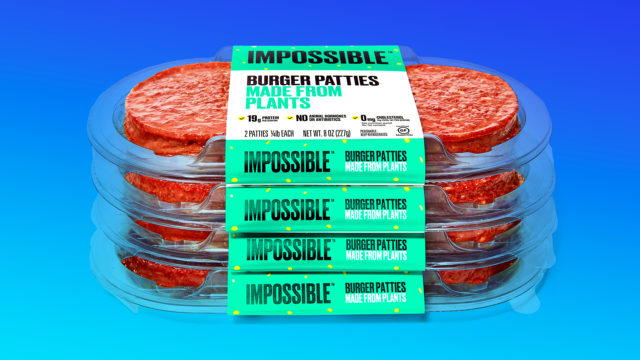
Source: Impossible Foods
More and more firms are getting involved in this fast-growing market, like Motif Foodworks (plant-based meat and dairy alternatives), Ginkgo Bioworks (custom-built microbes), BioMilq (lab-grown breast milk), Nature’s Fynd (fungi-grown meat and dairy alternatives), Eat Just (egg substitutes made from plant proteins), Perfect Day Food (lab-grown dairy products) or NotCo (plant-based animal products made through AI), to name but a few. The industrial meat-industry giants are also profiting from this blossoming market. Meat producers like Tyson Foods (which has invested in Memphis Meats and Future Meat Technologies which both create lab-grown meat replacements), Nestle, Cargill, Maple Leaf Foods, or Perdue Farms are thriving on this trend, selling products like sausages, burgers, and ground beef largely made from pea or soy protein. All these companies are backed up by high-ranked billionaires and Big Tech investors. Bill Gates alone has invested 50 million dollars in Impossible Foods and actively finances Beyond Meat, Ginkgo Bioworks, and BioMilq, as described above.
The perpetuation of ecologically damaging practices
Fake food advocates claim it is a real solution to climate change and solves environmental degradation, while also ironing out animal welfare concerns. For instance, Impossible Foods[34] declare their plant-based meat needs 96% less land, 87% less water and emits 89% fewer greenhouse gases than conventional animal-based products.
However, fake food has a larger carbon footprint than less-processed plant proteins[35]. Plant-based substitutes are up to seven times more GHG-intensive than whole pulses. Cell-based meat also emits more GHG than animal products, like pork or poultry. Recent research even suggests that over the long-term, the environmental impact of lab-grown meat[36] could be higher than that of livestock.
Moreover, fake food is advertised as “eco-friendly”, and yet it is made with proteins from pea, soy, or corn which are being grown on a large, industrial scale, relying on tillage, monocultures, toxic pesticides, and often, GMOs. The Impossible Burger is made with GMO Roundup-sprayed soya, leading to massive ecological devastation[37]. Total levels of glyphosate detected in the Impossible Burger by Health Research Institute Laboratories were 11.3ppb, making its consumption highly dangerous[38] as only 0.1ppb of glyphosate can destroy gut bacteria, damage to vital organs like the liver and kidneys, cause reproductive abnormalities, or even tumors, as glyphosate is also a “probable human carcinogen”. More broadly, the reliance on pesticides is directly linked with long-term chronic health problems, for consumers and farmers.
Other companies like Beyond Meat[39], who market their products as “cleaner” since they are free from genetically modified ingredients, still admit to not being organic[40], and still rely heavily on monocultures and pesticides. Ironically, these plant-based meat alternatives, which claim to save animals, water, and the environment, are instead directly contributing to the food system that is threatening global biodiversity[41], destroying wildlife, altering the soils, and polluting groundwater supplies[42]. Moreover, the fake food companies’ supply chains require excessive fossil fuel transport[43], like most industrial food.
The health impacts of hyper-processed fake foods
Not only is fake food harmful to the environment, but it also can be detrimental to human health. Plant-based substitutes are likely to have a range of adverse long-term health outcomes[44], due to them being highly processed and containing ingredients like isolated pea proteins and canola oil.
New additives also made through synthetic biology are being added to these products. For example, to make the Impossible Burger appear to “bleed” like real meat, a“heme” molecule is added which comes from soy leghemoglobin, a colorant produced in genetically engineered yeast. According to the Center for Food Safety, the FDA didn’t conduct adequate long-term testing[45] before approving the color additive in 2019, and after a short-term rat trial[46] several potential adverse effects were detected like changes in weight gain, changes in the blood that can indicate inflammation or kidney disease, disruptions in the reproductive cycle and possible signs of anemia. Despite the lack of evidence that the additive is safe, Impossible Foods’ products containing genetically engineered heme are now being sold in supermarkets across the United States, exemplifying a deregulatory environment that prefers corporate profit and influence over public health.
The entire process of isolating plant-based proteins can also have dangerous consequences[47] for human health. Many anti-nutrients are found within soy that can produce harmful health effects, such as digestive disorders, hormone imbalances, autoimmune diseases, obesity, digestive disorders, neurological conditions, or immunologic reactions. Especially as the soy and pea protein primarily used in most plant-based meats is heavily processed through high heating, chemical extractions and isolations of proteins, and now genetic altering, generating compounds that are not naturally found in foods.
Finally, artificially created animal products sometimes lack several natural nutrients or benefits. For instance, lab-grown milk such as BioMilq’s can’t change in response to the child’s need, as real breast milk can. It contains no hormones or bacteria from the mother’s biome and, more importantly, it does not have antibodies[48], which are vital to babies.
Plant-based meats, on the other hand, do not meet the nutritional requirements that are fulfilled by real animal foods. Simply adding isolated proteins, vitamins, and minerals to diets does not confer the same health benefits[49] as when these nutrients are ingested as whole foods, which contain thousands of compounds acting in synergy. Plant-based burgers aren’t healthier than animal products[50], including red meat.
Patenting: making profit from life
Far from ending climate change or world hunger, the patenting of artificial fake food growing techniques becomes yet another instrument of profit-making by corporations and billionaires. Especially as 20 patents[51] are now assigned to Impossible Foods, with over 100 additional patents pending[52] for other fake meat proxies, from chicken to fish.
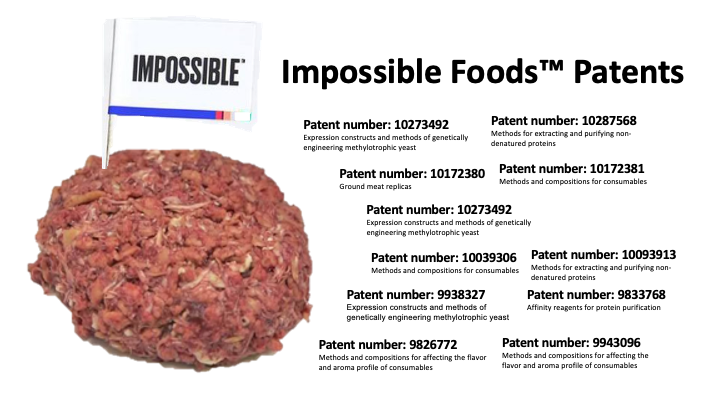
© Seth J. Itzkan, Soil4Climate
It’s no wonder that big plant-breeding companies like Bayer see a great opportunity in the plant-based industry boom[53]. In a 2019 investor event in Missouri, Bob Reiter, Bayer’s head of research and development at the company’s crop science division, said that plant-based meat companies “are sourcing different types of crops and that could also create opportunity for us, being a company that is a plant-breeding company”.
This patenting logic also reduces animals and nature to an “improvable technology”, in the words of Pat Brown, CEO, and founder of Impossible Foods. According to him[54], “animals have just been the technology we have used up until now to produce meat”. This means they can simply be replaced by more efficient technologies like artificial food. Fake food separates humans from nature and food from life. But we need to think beyond our strictly human needs and understand the needs of the ecological systems in which we are embedded. We cannot address the pressing environmental crisis without transforming our relationship with nature.
Missing the point of regenerative agriculture
Fake food shifts political power away from organic farmers and local markets toward biotech companies. It disregards local and indigenous knowledge and diverse food cultures that have evolved alongside diverse ecosystems. Moreover, it completely ignores the solutions offered by the growing regenerative agriculture movement. While concerns about industrial meat production are legitimate, regenerative animal grazing practices[55] can actually improve biodiversity, soil health and actively sequester carbon into the soil[56] by grooming and fertilizing vegetation and soil. Such models have the potential to substantially help mitigate climate change[57], or at least not exacerbate it further, and to repair damaged soils and slow desertification processes. This means that, in some cases, meat from grass-fed animals can have a lower ecological footprint than plant-based burgers. Studies by Quantis International demonstrated a +3.5 CO2-eq emissions/per kg[58] product in the life cycle analysis of the Impossible Burger, versus −3.5 CO2-eq/per kg[59] for beef produced using regenerative grazing practices, meaning that over the lifecycle of the animal more carbon was sequestrated than emitted.
Fake food investors and advocates fail to see how the real problems lie in the industrial agriculture model, rather than in meat production alone. Pointing toward the need to implement agroecological practices and agricultural diversity[60] to ensure a healthier environment and food sovereignty on a global scale.
Fake food is a fake solution, that aims to replace meat without challenging the profit-driven capitalist food and farming industry. This mindset explains why we will soon see Beyond Meat burgers in McDonald’s plant-based menus[61] when we should instead focus on the necessity for real regenerative agriculture and systemic change to protect nature and people’s health.
Biodiversity and Agroecology are True Solutions to Climate Change
Climate change and its very real consequences cannot be fully addressed without recognizing the central role of the industrialized and globalized food system in creating the climate crisis by contributing 44% to 57% of all greenhouse gas emissions through deforestation, animals in concentrated animal feeding operations (CAFOs), plastics and aluminum packaging, long-distance transport, and food waste.[62] Further industrialization, globalization, and now digitalization as promoted by the BMGF would mean further promotion of commercial seeds, toxic chemical use, high water usage, giant gas-guzzling farm equipment, and a massive fossil fuel-based global transport and production system, which would directly risk the rise of this GHG contribution. Not to mention, as has been shown during the initial Coronavirus lockdowns in 2020, these globalized and industrialized food systems are also significantly more vulnerable to disruptions, something climate change is already accelerating. Therefore, the way we produce our food should play an important role in how we reduce greenhouse gas emissions and directly adapt to climate change.
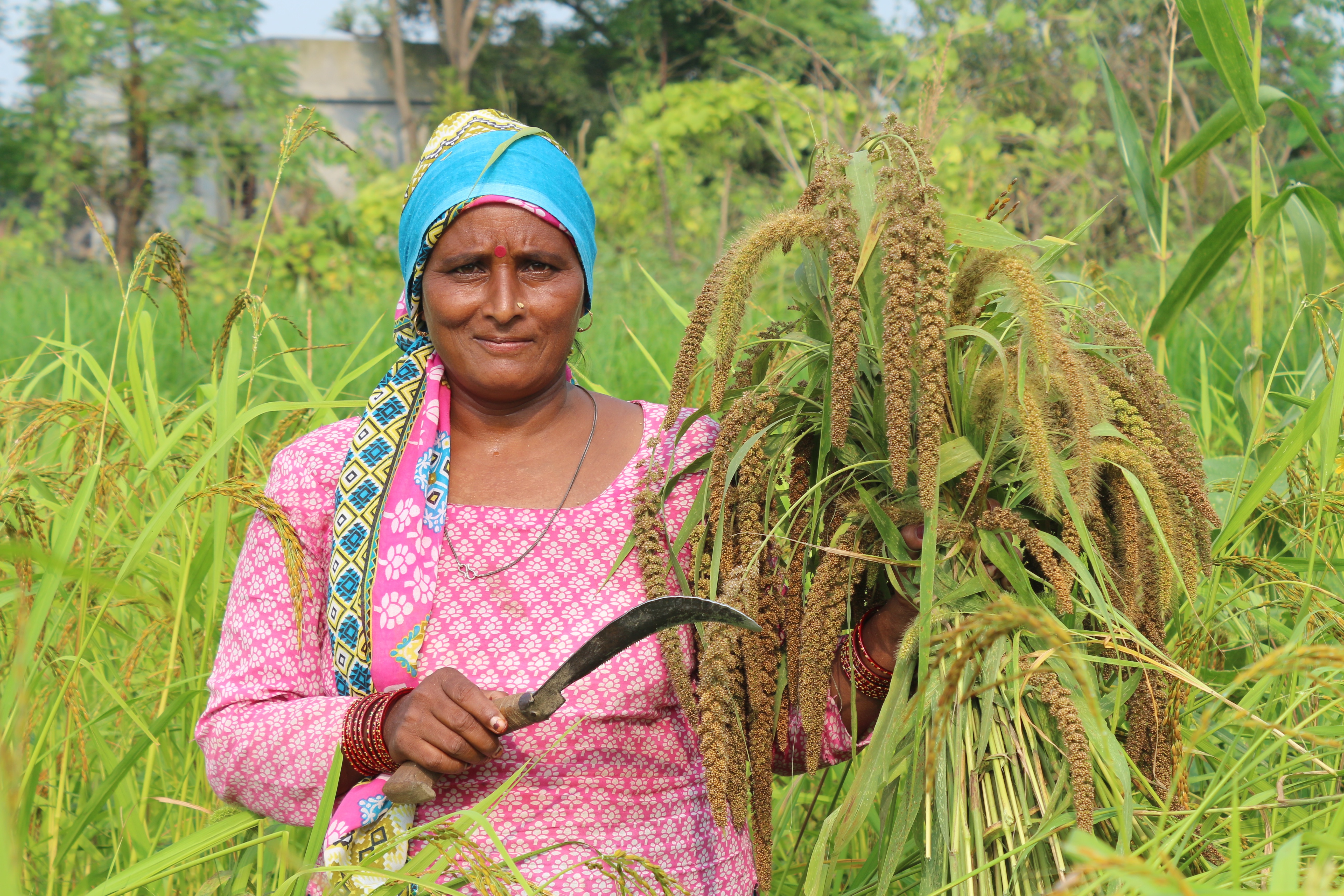
© Drona Chetri, Navdanya
We have a choice to not go further down the path that has already destroyed biodiversity, farmers’ lives, and rural economies and is now threatening to fully close off the future by destroying our planet. Especially as there are other paths that farmers across the world have walked for nearly 10,000 years, which have been continually rejuvenated through diverse agroecological systems. An agroecological path that can now show the way toward a more ecological future and is now being walked by local, diverse food communities across the world as a way to bring in a new paradigm of living in harmony with nature.
Agroecology is based on a broad set of principles and includes diverse ways of farming with nature and rejuvenating biodiversity through living seed, soil, and local food communities, without the use of chemicals. From seed to table, a diversity of movements is formed by a variety of actors including small farmers, gardeners, civil society organizations, citizens, policymakers, researchers, and international organizations. Movements can also take many forms including, organic farming, permaculture, biodynamic, regenerative farming, Masanobu Fukuoka’s vision of natural farming[63], local/ zero kilometer food chains, cooperative models of production and consumption, community-supported agriculture (CSAs), farmers markets, biodistricts[64], community and school gardens, urban farms, community seed banks,[65] slow food movements and revival of traditional[66] and forgotten foods, as well as hundreds of thousands of local farming traditions which have evolved over millennia. All of these approaches adapt agroecological methods to local contexts, to fit local needs, traditions, and knowledge systems. These traditions and approaches all put care for people and the land first, and place food sovereignty at the center of their local circular, cyclical, biodiverse, healthy, and sustainable food economies. Through these diverse methods, small farmers are feeding their local communities[67] healthy, nutritious food while simultaneously preserving ecosystemic health.
Agroecological food systems are a proven way to decrease CO2 emissions through actively sequestering greenhouse gases.[68] This is done through reorienting food supply chains to local food economies that eliminate fossil fuel-intensive methods and global supply chains, replacing them with resource recycling, low-intensity inputs which mimic nature’s nutrition, and hydrologic cycles to heal the soil and biodiversity.[69] It is also done through strengthening soils by increasing soil biodiversity, contributing both to fix carbon dioxide back into soils while reducing the need for chemical fertilizers and pesticides. Healthy soils also help sustain increased biodiversity, reducing pest and disease pressures.[70] To be specific, it has been estimated that through widespread agroecological and organic farming conversions 40 percent of the world’s agriculture greenhouse gas emissions could be mitigated in a minimum implementation scenario and up to 65 percent in a maximum carbon sequestration scenario.[71]
Along with providing a long-lasting solution to climate change, the transition to agroecological food and farming systems would also ensure the livelihoods of more than 1.5 billion smallholder farmers globally, along with working to ensure food sovereignty in the world’s most vulnerable populations. All over the world, these food communities are already transitioning to this ecological and democratic path, thus sowing the seeds of a food system in the hands of communities, women, farmers, and consumers free of corporate control, poisons, food miles, plastics, and patents. They are creating resilience in the face of deepening ecological and economic vulnerabilities through reclaiming seed, food, and knowledge as commons.
Agroecological solutions to climate change are based on a systemic approach that acknowledges the root cause of our crises, a deep understanding of living processing, and therefore, embodying a different vision of what food systems transformation could look like at the political, social, and economic levels. This true, agroecological transformation is incompatible with the industrial agriculture paradigm, as it requires a complete shift away from the hyper-centralized, corporate-controlled industrial food system.
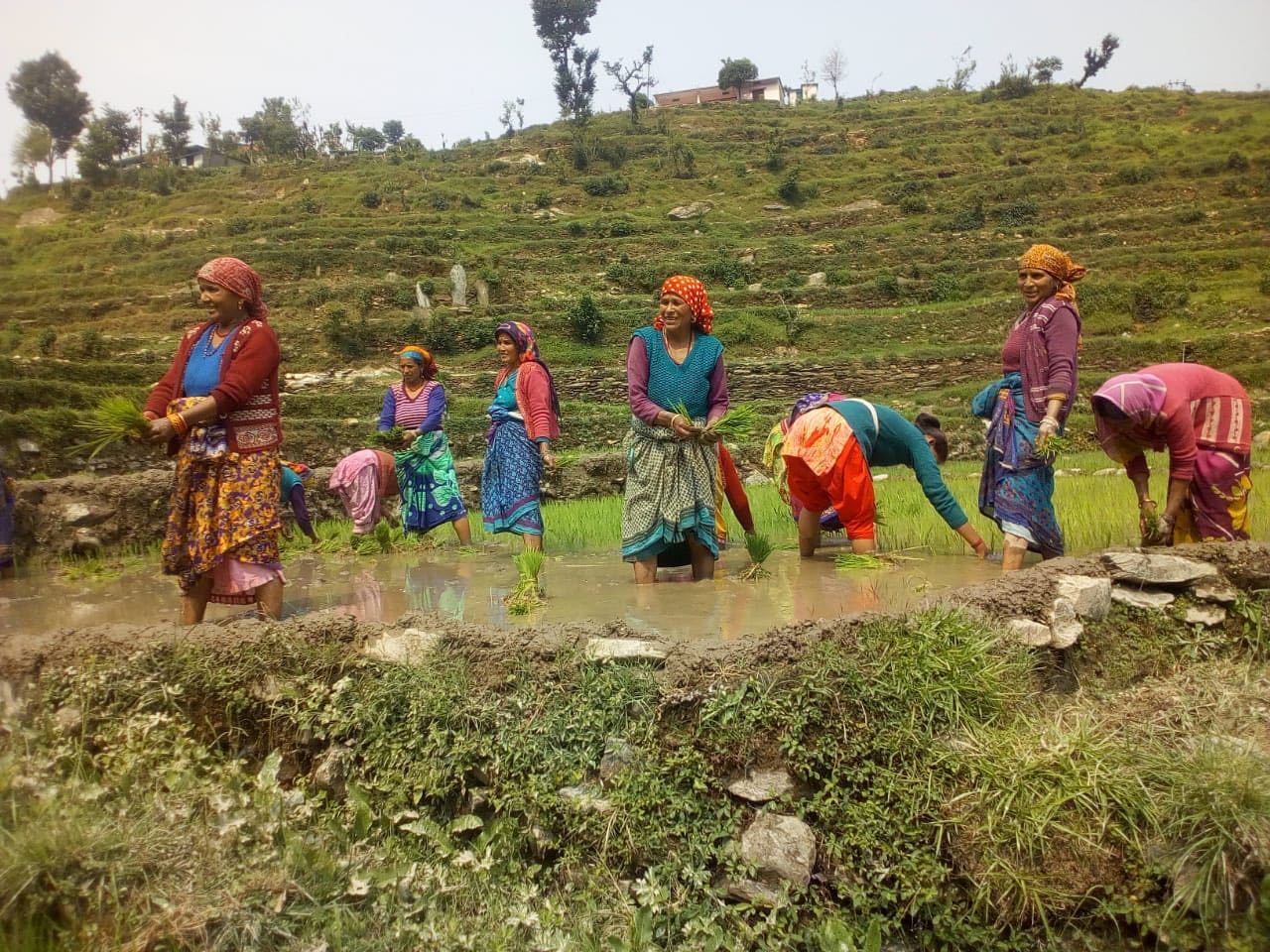
Agroecology and biodiversity-based approaches allow farmers to feed their local communities while preserving and regenerating ecosystems – © Navdanya
So in reality, the Gates’ strategies have nothing to do with lifting poor people out of poverty or fighting climate change. There is nothing altruistic, coy, or ‘optimistic’ about Gates and his foundation. Instead, it is a blatant attempt for the accumulation of power through the stubborn imposition of a failed paradigm. The level of influence accumulated by Gates, a billionaire who actively admits his limited knowledge of the problems he is attempting to solve, stands to take power away from democratic governance, and calls for climate and ecological justice by replacing democratic decisions through enforcing policies that adhere to his whims. All the while usurping much needed attention, funds, and policy away from a diverse agroecological transformation.
In other words, Bill Gates and his fellow private business partners will continue to produce exponentially worse problems than the ones they propose to ‘solve’, while simultaneously working to concentrate ever more power into private hands through the dogma of technology. These described technologies are used as methods of direct imposition, without any democratic, ethical, social, or ecological assessment. All the while substituting complex, diverse, self-organized, autopoietic systems, creating a new level of illusion that is propelling us faster toward collapse.
In the end, two distinct futures of food and farming are emerging – one leads to the regeneration of our planet, our soils, our biodiversity, our water, our rural economies and farmers’ livelihoods, our health, and our democracy. The second road leads to the collapse of the planet’s ecosystems and of socioeconomic systems that sustain society. The future of diverse species, our common human future, and our daily bread depends on which road we take.
© Navdanya International 2021
Navdanya International
Via Marin Sanudo 27, 00176 Rome
Piazzale Donatello 2, 50132 Florence Italy
Contacts: info@navdanyainternational.org – www.navdanyainternational.org
Cover Illustration: Marion Bessol
Download pdf
References
[1] Schwab, Tim. 2021. “Bill Gates, Climate Warrior. And Super Emitter.,” February 16, 2021. https://www.thenation.com/article/environment/bill-gates-climate-book/.
[2] ‘Bill Gates Joins Blackstone in Bid to Buy British Private Jet Services Firm’. Rupert Neate, The Guardian, 9 Jan. 2021, http://www.theguardian.com/technology/2021/jan/09/bill-gates-joins-blackstone-in-bid-to-buy-british-private-jet-firm.
[3] Gates to a Global Empire, Navdanya international, Oct. 2020. https://navdanyainternational.org/es/publications/gates-to-a-global-empire/.
[4] Dentico, Nicoletta. “The Philanthropic Monopoly of Bill and Melinda Gates”, in Gates to a Global Empire, Navdanya international, Oct. 2020. https://navdanyainternational.org/wp-content/uploads/2021/02/1-THE-PHILANTHROPIC-MONOPOLY-OF-BMGF.pdf
[5] Community Alliance of Global Justice / AGRA Watch, “Messengers of Gates’ agenda: how the Cornell Alliance Spreads Disinformation and Discredits Agroecology”, in Gates to a Global Empire. Navdanya international, Oct. 2020. https://navdanyainternational.org/wp-content/uploads/2021/02/1-MESSENGERS-OF-GATES%E2%80%99-AGENDA.pdf
[6] Dentico, Nicoletta. “The Power of Propaganda and the Language of Persuasion”, in Gates to a Global Empire, Navdanya international, Oct. 2020. https://navdanyainternational.org/wp-content/uploads/2021/02/1-THE-POWER-OF-PROPAGANDA.pdf
[7] Schwab, Tim. “Bill Gates, Climate Warrior. And Super Emitter”, Feb. 2021, The Nation, https://www.thenation.com/article/environment/bill-gates-climate-book/
[8] ‘The Sugar Daddy of Geoengineering’. ETC Group, 14 Oct. 2020. https://etcgroup.org/content/sugar-daddy-geoengineering.
[9] Ibid.
[10] Dentico, Nicoletta. “Bill & Melinda Gates: the Dystopia of the Green Revolution in Africa”, in Gates to a Global Empire, Navdanya international, Oct. 2020. https://navdanyainternational.org/wp-content/uploads/2021/02/1-THE-DYSTOPIA-OF-THE-GREEN-REVOLUTION-IN-AFRICA.pdf
[11] Wise, Timothy. “Gates Foundation’s Green Revolution Fails Africa’s Farmers”, in Gates to a Global Empire, Navdanya international, Oct. 2020. https://navdanyainternational.org/wp-content/uploads/2021/02/1-FAILS-AFRICA%E2%80%99S-FARMERS.pdf
[12] “Gates Ag One and the Recolonisation of Agriculture”, in Gates to a Global Empire, Navdanya international, Oct. 2020. https://navdanyainternational.org/wp-content/uploads/2020/12/GATES-AGONE-Navdanya-layout.pdf
[13] Cabaleiro, Fernando. “Gates Ag One in Argentina”, in Gates to a Global Empire, Navdanya international, Oct. 2020. https://navdanyainternational.org/wp-content/uploads/2021/02/1-GATES-AG-ONE-IN-ARGENTINA.pdf
[14] Gates, Bill. “Why I Love Fertilizer”, Gates Notes, 14 Nov. 2018. https://www.gatesnotes.com/Development/Why-I-love-fertilizer
[15] S, Robert, et al. ‘Fertilizer Use Responsible for Increase in Nitrous Oxide in Atmosphere’. Berkeley News, 30 Nov. 2001. https://news.berkeley.edu/2012/04/02/fertilizer-use-responsible-for-increase-in-nitrous-oxide-in-atmosphere/
[16] Bill Gates: GMOs Will End Starvation in Africa. Wall Street Journal on YouTube. https://www.youtube.com/watch?v=s2jHpyJAHCU
[17] Latham, Jonathan. ‘God’s Red Pencil? CRISPR and Myths of Precise Genome Editing’. Independent Science News, 25 Apr. 2016. https://www.independentsciencenews.org/science-media/gods-red-pencil-crispr-and-the-three-myths-of-precise-genome-editing/
[18] Herper, Matthew. ‘Bill Gates And 13 Other Investors Pour $120 Million Into Revolutionary Gene-Editing Startup’. Forbes, https://www.forbes.com/sites/matthewherper/2015/08/10/bill-gates-and-13-other-investors-pour-120-million-into-revolutionary-gene-editing-startup/
[19] Biovision Foundation for Ecological Development & IPES-Food. Money Flows: What is holding back investment in agroecological research for Africa? Biovision Foundation for Ecological Development & International Panel of Experts on Sustainable Food Systems, 2020. http://www.ipes-food.org/_img/upload/files/Money%20Flows_Full%20report.pdf
[20] ‘The Global Commission on Adaptation’. Global Center on Adaptation, https://gca.org/about-us/the-global-commission-on-adaptation/
[21] ‘5 Ways Technology Is Helping Farmers to Adapt’. Global Center on Adaptation, 12 Dec. 2020, https://gca.org/5-ways-technology-is-helping-farmers-to-adapt/
[22] Loboguerrero Rodriguez, Ana María, et al. Feeding the World in a Changing Climate: An Adaptation Roadmap for Agriculture. Working Paper, The Global Commission on Adaptation, Oct. 2018. cgspace.cgiar.org, https://cgspace.cgiar.org/handle/10568/97662.
[23] ‘DSM Names Feike Sijbesma Honorary Chairman’, DSM, 20 Jan. 2020. https://www.dsm.com/corporate/news/news-archive/2020/03-20-dsm-names-feike-sijbesma-honorary-chairman.html
[24] BEV Board & Investors, Breakthrough Energy. https://www.breakthroughenergy.org/investing-in-innovation/bev-board-and-investors
[25] Motif Foodworks, http://madewithmotif.com/
[26] Ginkgo Bioworks, https://www.ginkgobioworks.com/
[27] About, Motif Foodworks, https://madewithmotif.com/about/
[28] Nature’s Fynd https://www.naturesfynd.com/
[29] BioMilq, https://www.biomilq.com/
[30] Lane, Jim. ‘Pivot Bio Raises $100M as It Proves out Why It’s Agtech’s Next Billion-Dollar Baby’, Biofuels Digest. May 6, 2020. https://www.biofuelsdigest.com/bdigest/2020/05/06/pivot-bio-raises-100m-as-it-proves-out-why-its-agtechs-next-billion-dollar-baby/
[31] Policy Solutions, Breakthrough Energy. https://www.breakthroughenergy.org/us-policy-overview
[32] Temple, James. ‘Bill Gates: Rich Nations Should Shift Entirely to Synthetic Beef’. MIT Technology Review, Feb. 14, 2021. https://www.technologyreview.com/2021/02/14/1018296/bill-gates-climate-change-beef-trees-microsoft/
[33] Saigol, Lina and Keown, Callum. ‘Is Cell-Based Meat the Next Big Thing? Here Are 5 Companies Leading the Revolution’. MarketWatch, Oct. 8, 2020. https://www.marketwatch.com/story/is-cell-based-meat-the-next-big-thing-here-are-5-companies-leading-the-revolution-2020-10-06
[34] Sustainability, Impossible Foods, https://impossiblefoods.com/sustainable-food
[35] Santo, Raychel E., et al. ‘Considering Plant-Based Meat Substitutes and Cell-Based Meats: A Public Health and Food Systems Perspective’. Frontiers in Sustainable Food Systems, vol. 4, Aug. 2020, p. 134. https://doi.org/10.3389/fsufs.2020.00134
[36] Muraille, Eric. ‘“Cultured” Meat Could Create More Problems than It Solves’. The Conversation, Nov. 28, 2019. http://theconversation.com/cultured-meat-could-create-more-problems-than-it-solves-127702
[37] Thomas, Pat. ‘6 Reasons Impossible Burger’s CEO Is Wrong About GMO Soy’. Common Dreams, May 21, 2019. https://www.commondreams.org/views/2019/05/21/6-reasons-impossible-burgers-ceo-wrong-about-gmo-soy
[38] Honeycutt, Zen. ‘GMO Impossible Burger Positive for Carcinogenic Glyphosate’. Moms Across America, May 16, 2019. https://www.momsacrossamerica.com/gmo_impossible_burger_positive_for_carcinogenic_glyphosate
[39] ‘Beyond Meat May Be Bad For The Environment’, Seeking Alpha, Jun. 22, 2020. https://seekingalpha.com/article/4355008-beyond-meat-may-be-bad-for-environment
[40] FAQ, Beyond Meat, https://www.beyondmeat.com/faqs/
[41] ‘Our Global Food System Is the Primary Driver of Biodiversity Loss’. UN Environment, Mar. 2, 2021, http://www.unep.org/news-and-stories/press-release/our-global-food-system-primary-driver-biodiversity-loss
[42] ‘Advantages and Disadvantages of Monoculture Farming’. Conserve Energy Future, Mar. 1, 2020, https://www.conserve-energy-future.com/advantages-disadvantages-examples-monoculture.php.
[43] ‘Beyond Meat May Be Bad For The Environment’, Seeking Alpha, Jun. 22, 2020. https://seekingalpha.com/article/4355008-beyond-meat-may-be-bad-for-environment
[44] Lawrence, Mark A., and Phillip I. Baker. ‘Ultra-Processed Food and Adverse Health Outcomes’. BMJ (Clinical Research Ed.), vol. 365, May 2019, p. l2289. PubMed. https://doi.org/10.1136/bmj.l2289
[45] ‘Lawsuit Challenging FDA Approval of Novel Genetically Engineered Color Additive That Makes Impossible Burger’. Center for Food Safety, Jan. 29, 2021. https://www.centerforfoodsafety.org/press-releases/6256/lawsuit-challenging-fda-approval-of-novel-genetically-engineered-color-additive-that-makes-impossible-burger-bleed-moves-forward
[46] ‘Rat Feeding Study Suggests the Impossible Burger May Not Be Safe to Eat’. GMO Science, June 25, 2019. https://www.gmoscience.org/rat-feeding-studies-suggest-the-impossible-burger-may-not-be-safe-to-eat/
[47] Keough, Sara. ‘Artificial Animals – Part 2: The Hidden Dangers of Processed Plant Proteins’. Understanding Ag, Jan. 13, 2021, https://understandingag.com/artificial-animals-part-2-the-hidden-dangers-of-processed-plant-proteins/
[48] Kleeman, Jenny. ‘“I Want to Give My Child the Best”: The Race to Grow Human Breast Milk in a Lab’. The Guardian, Nov. 14, 2020, http://www.theguardian.com/lifeandstyle/2020/nov/14/i-want-to-give-my-child-the-best-the-race-to-grow-human-breast-milk-in-a-lab.
[49] Van Vliet, Stephan, et al. ‘Plant-Based Meats, Human Health, and Climate Change’. Frontiers in Sustainable Food Systems, vol. 4, Oct. 2020, p. 128. https://doi.org/10.3389/fsufs.2020.00128
[50] Lucas, Amelia. ‘Are Beyond Meat’s Plant-Based Burgers Healthier than Red Meat? Dietitians Say No.’ CNBC, July 4, 2019. https://www.cnbc.com/2019/07/03/are-beyond-meats-burgers-healthier-than-red-meat-dietitians-say-no.html
[51] Patents Assigned to Impossible Foods Inc. Justia Patents Search. https://patents.justia.com/assignee/impossible-foods-inc
[52] Itzkan, Seth. “Software to Swallow. Impossible Foods Should Be Called Impossible Patents”, in Gates to a Global Empire, Navdanya international, Oct. 2020. https://navdanyainternational.org/wp-content/uploads/2020/10/SOFTWARE-TO-SWALLOW.pdf
[53] Bellon, Tina. ‘Bayer Sees Potential Future Business in Plant-Based Meat Market’. Reuters, Aug. 1, 2019. https://www.reuters.com/article/us-bayer-agriculture-food-idUSKCN1UR5SF.
[54] Purdy, Chase. ‘Functional Foods Are Boring. Someone Tell Silicon Valley.’ Quartz, Sept. 1, 2018. https://qz.com/quartzy/1375904/functional-foods-are-boring-someone-tell-silicon-valley/
[55] Roulac, John W. ‘Making America’s Rivers Blue Again: Connecting the Dots Between Regenerative Agriculture and Healthy Waterways’. Common Dreams, Feb. 17, 2021. https://www.commondreams.org/views/2021/02/17/making-americas-rivers-blue-again-connecting-dots-between-regenerative-agriculture
[56] Reeder, J. D., and G. E. Schuman. ‘Influence of Livestock Grazing on C Sequestration in Semi-Arid Mixed-Grass and Short-Grass Rangelands’. Environmental Pollution, vol. 116, no. 3, Mar. 2002, pp. 457–63. https://doi.org/10.1016/S0269-7491(01)00223-8
[57] Teague, W. R., et al. ‘The Role of Ruminants in Reducing Agriculture’s Carbon Footprint in North America’. Journal of Soil and Water Conservation, vol. 71, no. 2, Mar. 2016, pp. 156–64. https://doi.org/10.2489/jswc.71.2.156
[58] ‘Comparative Environmental LCA of the Impossible Burger with Conventional Ground Beef Burger’, Quantis, Feb. 2019. https://assets.ctfassets.net/hhv516v5f7sj/4exF7Ex74UoYku640WSF3t/cc213b148ee80fa2d8062e430012ec56/Impossible_foods_comparative_LCA.pdf
[59] ‘Carbon Footprint Evaluation of Regenerative Grazing at White Oak Pastures’, Quantis, Feb. 2019. https://blog.whiteoakpastures.com/hubfs/WOP-LCA-Quantis-2019.pdf
[60] Khoury, C. K., et al. ‘Increasing Homogeneity in Global Food Supplies and the Implications for Food Security’. Proceedings of the National Academy of Sciences, vol. 111, no. 11, Mar. 2014, pp. 4001–06. https://doi.org/10.1073/pnas.1313490111
[61] ‘Beyond Meat Announces Strategic Global Agreement with McDonald’s’. GlobeNewswire NewsRoom, Feb. 25, 2021. https://www.globenewswire.com/news-release/2021/02/25/2182964/0/en/Beyond-Meat-Announces-Strategic-Global-Agreement-with-McDonald-s.html
[62] “Food and Climate Change: The Forgotten Link.” Grain, September 28, 2011. https://www.grain.org/e/4357
[63] Masanobu Fukuoka Natural Farm Official Site, https://f-masanobu.jp/en/
[64] Eco-Region’s Portal. https://www.ecoregion.info/
[65] Community Seed Banks, Navdanya. https://www.navdanya.org/site/living-seed/navdanya-seed-banks
[66] ‘Looking beyond the Spread on Our Tables, India Together’, India Together, Mar. 13, 2014. http://indiatogether.org/articles/tribal-food-fest-underlines-food-diversity-agriculture
[67] First Draft of the Policy Recommendation on “Agroecological and other innovative approaches”, CSM’s Preliminary Response, http://www.csm4cfs.org/wp-content/uploads/2017/12/CSMComments_FirstDraft_CFSPolicyRecs_Final.pdf
[68] “Regenerative Organic Agriculture and Climate ChangeA Down-to-Earth Solution to Global Warming.” 2020. Rodale Institute. https://rodaleinstitute.org/wp-content/uploads/rodale-white-paper.pdf.
[69] Altieri, Miguel A., and Clara I. Nicholls. 2020. “Agroecology and the Reconstruction of a Post-COVID-19 Agriculture.” The Journal of Peasant Studies 47 (5): 881–98. https://doi.org/10.1080/03066150.2020.1782891.
[70] Altieri, Miguel, and Clara Nicholls. 2004. Biodiversity and Pest Management in Agroecosystems. 2nd Edition. New York: CRC Press.
[71] (Skinner, C., Gattinger, A., Krauss, M. et al. The impact of long-term organic farming on soil-derived greenhouse gas emissions. Sci Rep 9, 1702 (2019). https://doi.org/10.1038/s41598-018-38207-w ).
Also read:
